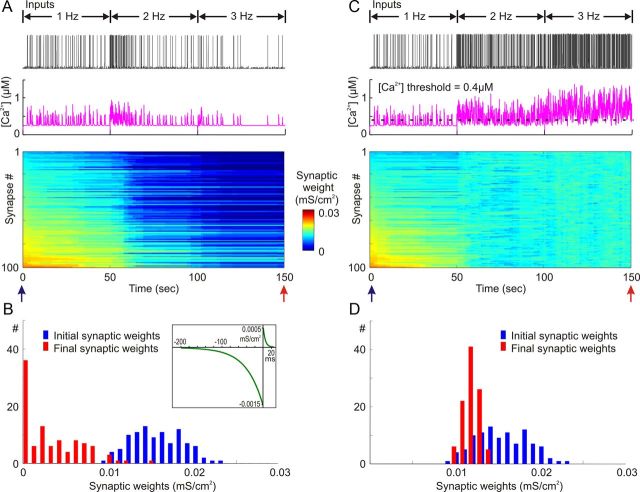Figure 5.
Heterosynaptic plasticity prevents runaway dynamics of synaptic weights produced by STDP with a negative bias. A, B, STDP with a negative bias leads to runaway dynamics of synaptic weights toward zero during background activity produced by weakly correlated inputs. Presynaptic spike trains (N = 100) at an average rate of 1 Hz during first 50 s of simulation, 2 Hz during 50–100 s, and 3 Hz during 100–150 s are shown. Cross-correlation of spike trains throughout the simulation was 0.348 ± 0.05. STDP rule with negative bias (τ+ = 5 ms, a+ = 0.5 × 10−3 mS/cm2, τ− = 40 ms, a− = 1.5 × 10−3 mS/cm2; B, inset) was implemented at each synapse. A, Membrane potential trace (top), changes of intracellular [Ca2+] (middle), and changes of synaptic weights, color coded, with synapses sorted by their synaptic weights at the beginning of the experiment (bottom). B, Distributions of synaptic weights at the beginning (blue; at 20 ms) and at the end (red; at 150 s) of the simulation experiment shown in A. Note runaway dynamics of synaptic weights leading to saturation at zero of about 40% of synapses, and associated dramatic decrease of postsynaptic firing rate despite an increase of presynaptic firing. C, D, Heterosynaptic plasticity prevents runaway synaptic dynamics toward zero weights and the associated decrease of postsynaptic firing. The same model as in A and B is shown, but with the mechanism for heterosynaptic plasticity as described in Figure 3, with the [Ca2+] threshold 0.4 μm (dashed line) added to each synapse. All conventions are same as in A and B. Note that synaptic weights are not saturated, but remain normally distributed within the operation range. Also note that in contrast to STDP-only model, postsynaptic firing rate does not express a dramatic decrease, but increases in parallel with increased presynaptic firing.

